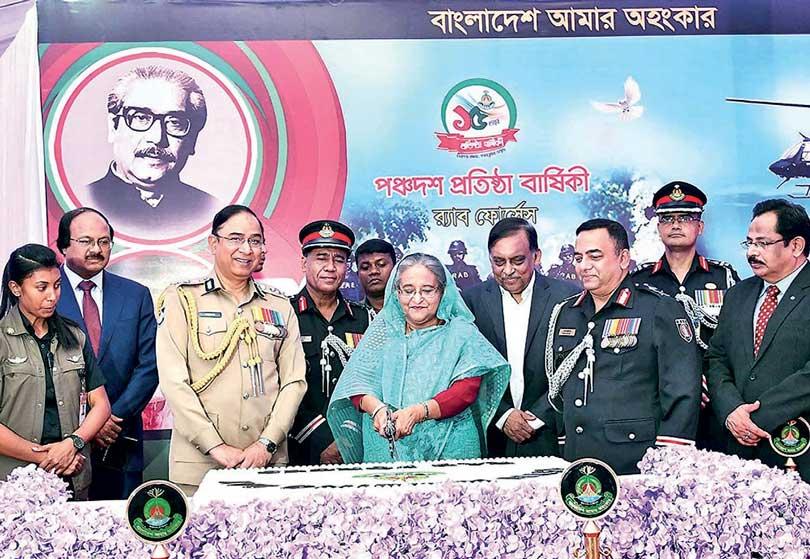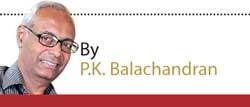Reply To:
Name - Reply Comment

Bangladesh marks the 15th anniversary of the anti-terrorist Rapid Action Battalion
 Muslim-majority Bangladesh was born out of an explicitly secular and linguistic movement spearheaded by Sheikh Mujibur Rahman. But it did not take long for the new born to show that it was “Islamic” as well as “Bengali”.
Muslim-majority Bangladesh was born out of an explicitly secular and linguistic movement spearheaded by Sheikh Mujibur Rahman. But it did not take long for the new born to show that it was “Islamic” as well as “Bengali”.
This was due to the failure of Bangladesh’s post-independence secular rulers to live up to their promises. With the failure of Mujib’s secular government, political Islam became the rallying point for the disgruntled.
Subsequently, unpopular military rulers seeking legitimacy strengthened political Islam by reviving and nurturing it. Pakistan also played a role in instigating and sustaining political Islam to get back Bangladesh which it lost in 1971.
Over time, political Islam became increasingly radical and terroristic. Successive governments in Dhaka were formally “secular” but were bending over backwards to carry Islamist forces with them, giving them legitimacy in the process. And whenever the State asserted its modern secular character, Islamist radicals would unleash terrorism to make the government mend its ways.
The Islamists saw abjuring Islam in favour of a “Bengali” ethno-linguistic identity as a mark of subservience to India which had been seeking a greater political and economic role in a country which it helped found by sending in its military in December 1971.
Over time, Islamism mixed with nationalism proved to be a potent political mix which governments found hard to fight.
Between January 2005 and December 2017, about 746 persons had fallen prey to Islamist terror and State counter-terror operations. According to a study, 91% of these ghastly incidents had taken place since 2013 when Prime Minister Sheikh Hasina of the Awami League was trying to put Bangladesh back on its original secular track.
In 1977, before Hasina came to power, the constitution replaced secularism by “absolute trust and faith in almighty Allah”. Military ruler Ziaur Rahman’s Bangladesh Nationalist Party (BNP) fostered the notion that Bangladesh is Islamic. Between 1976 and 1979, Zia legalized religious political parties and allowed Islamists, who had worked with the Pakistani Army during the liberation war, to participate in government.
The Bangladesh Jamaat-e- Islami (BJeI), banned by Mujib, was able to publicly rejoin Bangladeshi politics in 1979. Gen. H.M. Ershad, the country’s second military dictator, made Islam Bangladesh’s state religion. He even gave cabinet positions to two BJeI “war criminals”.
The world was unaware that a whole generation of Bangladeshis had grown up with no love for Pakistan or the Islamic movement prior to the formation of Pakistan in 1947
In 1990, democracy returned to Bangladesh. But it did not augur well for secularism. The BNP led by Gen. Zia’s widow, Begum Khaleda Zia, continued to cultivate and accommodate Islamic radicals. But this was vehemently opposed by the Awami League now led by Sheikh Mujib’s daughter Sheikh Hasina Wazed.
While the “Battle of the Begums” raged, Bangladeshi militants returning from the “Jihad” in Afghanistan added fuel to the fire. They teamed up with the al-Qaeda Rohingya Solidarity Organization (RSO). RSO came to Bangladesh along with the 200,000 persecuted Rohingyas from Myanmar. Pakistan’s ISI, waiting in the wings, tied up with BJeI to turn Bangladesh into a launching pad to stage attacks in neighbouring India.
BJeI and its student wing, Islami Chhatra Shibir (ICS), the Jagrato Muslim Janata Bangladesh (JMJB) and Jamatul Mujahideen Bangladesh (JMB) attacked Hindus, Ahmadiyas and Awami League workers.
The JMJB and JMB merged under the leadership of Sheikh Abdur Rahman and Siddiqur Rahman, known as “Bangla Bhai” (Bengali Brothers). The Bangla Bhai became popular for providing instant justice. Mainstream politicians cultivated the “Bangla Bhai” and ran protection rackets with them till the BNP government led by Prime Minister Begum Zia felt the need to control them. The Rapid Action Battalion (RAB) was set up to fight the menace.
In August 2005, the JMB set off 459 bombs simultaneously in 63 of Bangladesh’s 64 districts to push the country into adopting Sharia law. The Harkat-ul-Jihad-al Islami Bangladesh (HuJI-B), founded in 1992, issued death threats against the feminist authoress Taslima Nasreen, who had to flee from Bangladesh. It tried to assassinate Prime Minister Sheikh Hasina.
The Pakistan-based Lashkar-e-Taiba (LeT) staged many attacks in Bangladesh. Many Bangladeshis resident in the UK went to Syria to fight alongside the Islamic State (IS). Adept at using sophisticated communication technologies, the IS influenced well educated and well-heeled young Bangladeshi Muslims.
The killers of 18 foreigners and two Bangladeshis in the up-market Holey Artisan Bakery in Dhaka on July 1, 2016, were well-heeled students from Dhaka’s private North-South University.
In 2009, despite the wide berth given by the predecessor BNP regime to Islamic radicals, Sheikh Hasina set up a War Crimes Tribunal to try persons who had committed war crimes during the liberation struggles as auxiliaries of the Pakistani army. There had been a mass student movement since 2007 seeking the trial of war criminals.
But the Jamaat-e-Islami, the main target of the trials, and human rights groups cried foul saying that the procedures did not accord with international norms. Apart from Pakistan which passed many resolutions against the trials, Malaysian leader Mahathir Mohammad and Turkish leader Erdogan appealed for clemency. But Sheikh Hasina was undeterred. The trials continued and many were sent to the gallows.
Hasina was adept at resisting foreign pressure. When the US put tremendous pressure to get Bangladesh to let an island be used as a US base, she put her foot down.
Hasina was undeterred even by the country-wide mayhem unleashed by the Jamaat because she had the support of Bangladeshi youth, including youth from the private universities. In 2013, the broad-based Shahbad movement backed her to the hilt, demanded capital punishment and a ban on the Jamaat.
Explaining this a Bangladeshi commentator said: “The world was unaware that a whole generation of Bangladeshis had grown up with no love for Pakistan or the Islamic movement prior to the formation of Pakistan in 1947. These were young students and professionals born after 1971. Hasina was cued into this generation.”
An independent minded person, Hasina resisted the temptation to go along with the Western view that the Holey Artisan Bakery attack was the handiwork of the international lslamic State and not a local group. She sensed that attempts were being made to link up the massacre with the IS so that the Western agencies could enter the investigation process and infiltrate the Bangladeshi security set up. She therefore doggedly held on to the view that the massacre was a local job.
She refused to yield to pressure from the Bangladesh elite to release some of the suspects saying that law enforcement machinery could not be fettered.
To get the ramifications of the network which carried out the July 1, 2016 attack, and to avoid harassment of the public, Hasina appealed to families to inform the police of any missing persons or anyone moving about suspiciously in their neighbourhood. This unearthed information about more than 200 persons, which helped crack the case.
Hasina knew that people were tired of terrorism and governments which tolerated and fostered radicalism and helped radicalism metamorphose into terrorism. Therefore her appeal for “Help to Help You” had the desired effect. People came out with useful information.
The Prime Minister tackled the drug menace in the same way. She knew drug traffickers were terrorizing locals and forcing them to tolerate their nefarious activities. That was why, despite the international cry over extra-judicial killings, there was no local resistance or disapproval of the strong arm methods she used.
Political commentators predicted that Hasina and her Awami League would lose the last elections because of “human rights violations” under her rule since 2009. But she won handsomely. The opposition BNP was in disarray and did not contest and the Jammat had gone into hiding as it had lost its base.
Hasina knew that people were tired of terrorism and governments which tolerated and fostered radicalism and helped radicalism metamorphose into terrorism
However, Hasina is not oblivious to the fact that Bangladesh is an Islamic country and the hold of religion is strong in the rural areas. Therefore she has come to an understanding with Hefazat-e-Islam which runs thousands of Qawmi Madrasahs.
The Hefazatis preferred to the Jamaat because unlike the Jamaat, the Hefazat was not against the struggle for freedom from Pakistan.
Hasina yielded to the Hefazat’s demand for recognition of their certificates for government jobs. She removed from the Supreme Court, a statue of justice showing a lady in a sari holding the scales of justice, which the Hefazat said was un-Islamic. She did not allow writer Tasleem Nasreen to come back to Bangladesh as she had ridiculed Islam. She criticized secular bloggers for going overboard in their posts.
Hasina has mastered the art of balancing secularism and Islam and has curbed radicalism and terrorism with a mixture of guile and firmness.